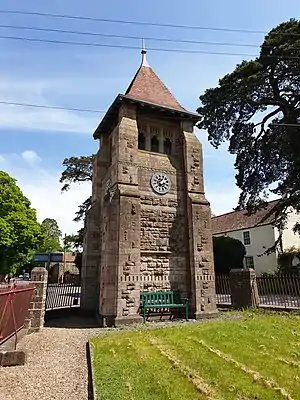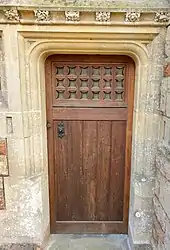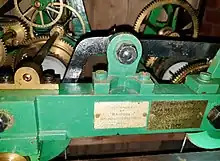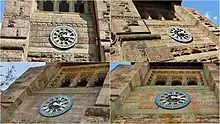Jubilee Clock Tower, Churchill
The Jubilee Clock Tower, striking clock, and drinking fountain, is a Grade II listed building in the village of Churchill, North Somerset, built to commemorate the Diamond Jubilee of Queen Victoria in 1897. It stands on a plot between Dinghurst Road and Front Street, and is a prominent landmark at the entrance to the village. Designed by Joseph Foster Wood of Foster & Wood, Bristol, the tower is made of local stone and is of perpendicular Gothic style.
| Jubilee Clock Tower | |
|---|---|
 Jubilee Clock Tower | |
| Type | Clock tower |
| Location | Churchill, North Somerset, England |
| Coordinates | 51.333996°N 2.799628°W |
| Height | 12 metres (40 feet) |
| Founded | 1897 |
| Founder | Sidney Hill |
| Built | 1898 |
| Built for | Diamond Jubilee of Queen Victoria |
| Restored | 1976–77 |
| Architect | Joseph Foster Wood |
| Architectural style(s) | Perpendicular Gothic style |
| Governing body | Churchill parish council |
Listed Building – Grade II | |
| Official name | Jubilee Clock Tower and attached walls and railings |
| Designated | 19 January 1987 |
| Reference no. | 1129198 |
 Location of Jubilee Clock Tower in Somerset | |
The tower has a cast iron clock face on each of its four sides with one mechanism driving the clock hands. The escapement and clockwork was supplied by J. B. Joyce & Co in 1898 and is wound weekly by volunteers. The clock strikes the hours and chimes the Westminster Quarters. Responsibility for maintenance of the tower transferred to the parish council after the original trust could no longer afford to maintain it. The whole structure, tower, walls, and railings, was designated as a Grade II listed building on 19 January 1987, nearly ninety years after the tower was built.
History
Inception
In 1897, Sidney Hill, a local businessman and benefactor, purchased the old turnpike house near the Nelson Arms pub in Churchill, North Somerset, and a house and plot of land between Dinghurst Road and Front Street, near the entrance to Churchill village. Both sites were in a state of disrepair and were unsightly.[1] Hill planned to clear the old buildings and debris, plant ornamental shrubs, and enclose the plots with iron railings; similar in design to the then plantation in front of the nearby Methodist church and schoolroom that Hill had built in Front Street in 1881.[2] Furthermore, his intention was to build a clock tower on the site to mark the Diamond Jubilee of Queen Victoria in 1897.[1]
Design
Hill engaged Joseph Foster Wood of Foster & Wood, Bristol, to design the tower.[3] Wood was the son and nephew of the founders of Foster & Wood.[4] They were a busy architectural practice in Victorian Bristol and many landmark buildings in the city were designed by them, including Fosters Almshouse (1861), Colston Hall (1864), Grand Hotel, Broad Street (1864 to 1869), Bristol Grammar School (1875), and a large number of Wesleyan chapels.[5] Hill had used the same practice to design the Methodist church and schoolroom at Churchill.[2]
Build
The tower was built by the end of 1897, and in the following year, J. B. Joyce & Co installed the bell and clock mechanism.[6] On 31 July 1901, Hill gifted the tower, and the adjacent schoolroom, to the Churchill Memorial Chapel and School Trust.[7] Graham Clifford Awdry, Joseph Foster Wood's former business partner, wrote in Wood's obituary, "A charming memorial tower at Churchill, Somerset, is a good specimen of his originality."[3]
Restoration
By March 1974, the wall surrounding the tower was crumbling, and the tower stonework required pointing and cleaning. The clock's winding mechanism was also in a poor state of repair and it would have cost a thousand pounds to mechanise it. The trust responsible for the upkeep of the tower had an annual income of five hundred pounds and was paid twelve pounds (equivalent to one hundred pounds in 2020) per year by the parish council to maintain the tower.[8] The trust had asked for more help from the parish council as it was not possible to maintain the tower and the other church properties for which they were responsible.[6]
It was recognised that the long-term future of the tower lay either with listing the tower as an historic monument or that the parish council take over the maintenance of the tower.[8] By September 1976, the trust had applied to the Charity Commissioner to have its responsibilities transferred to the parish council.[9] In the same month, John Edgar Howard Smith, the managing director of Smith of Derby Group, the holding company of J. B. Joyce & Co, wrote to the parish council offering to carry out a free survey of the clock, although at the time of Smith's letter, the trust had recently refurbished and renovated the mechanism at a cost of two hundred pounds.[6]
In 1977, for the Queen's Silver Jubilee, the tower was cleaned by Arthur Raymond "Ray" Millard, former chairman of Churchill parish council, and a team of volunteers.[10] In 1979, their work on restoring the tower was commemorated through a plaque affixed to the west side of the tower.[11] In the 1980s, Millard was interviewed about his life and work as site manager for the construction of Bristol City Hall. A cassette tape recording and transcript of this interview is held in the archives of Bristol Museum & Art Gallery.[12]
Maintenance
On 25 October 1978, the parish council established a charitable trust to maintain the clock and tower as a public amenity.[13] The Open Spaces and Allotments committee of the council is now responsible for the upkeep and maintenance of the tower.[14] In 1980, contractors were engaged by the council to treat the tower with a chemical to discourage pigeons from roosting and soiling the ornamental stonework.[15] On 19 January 1987, the tower was designated as a Grade II listed building,[16] and in the same year, overgrown moss was removed from the wall and iron railings surrounding the tower.[17] In 2017, the clock was repaired and serviced, and the tower wall enclosure on Front Street rebuilt.[18] The tower was opened to the public in the weeks leading up to the Platinum Jubilee Central Weekend at the beginning of June 2022.[19]
Features and architecture
The tower has a cast iron clock face on each of its four sides, with Roman numerals indicating twelve hours on each face. The clocks are attached to a square tower that has buttresses to the first floor.[16] One mechanism drives the faces on all sides of the tower.[16] The second floor holds the bell and a clockwork that is wound weekly by volunteers.[8]
| Features and architecture[16] | |||||||||||||||||||||||||||||||||||
|---|---|---|---|---|---|---|---|---|---|---|---|---|---|---|---|---|---|---|---|---|---|---|---|---|---|---|---|---|---|---|---|---|---|---|---|
|
 The tower as photographed from Dinghurst Road, Churchill (west side) |
 Drinking fountain with cast iron tap and water pump fittings (east side) |
 Entry to the tower is through a wooden door (north side) | ||||||||||||||||||||||||||||||||
 Plaque commemorating the volunteers who cleaned the tower for the Queen's Silver Jubilee (west side) |
 Clockwork installed on the second floor of the tower |
 The four clock faces located on each side of the tower | |||||||||||||||||||||||||||||||||
A drinking fountain, with a cast iron tap and water pump fittings, is built into a niche on the east side of the tower.[16][lower-alpha 2] A bench has been installed outside the Reading Room in the tower enclosure and a new pathway constructed to provide disabled access.[22] The inscription on the string course above the clock faces, and below the bell floor, reads as follows:
- West: "June 20 1897 This tower"
- South: "& clock was erected by Sidney Hill JP of Langford House in"
- East: "this parish to commemorate the sixty years of the beneficent"
- North: "reign of her Most Gracious Majesty Queen Victoria"
Footnotes
References
- "Churchill. The Diamond Jubilee". Weston‑super‑Mare Gazette, and General Advertiser. 17 April 1897. p. 8. OCLC 751660952. Retrieved 10 June 2020 – via British Newspaper Archive.
- "Churchill. The New Wesleyan Memorial Chapel". Weston Mercury. Weston‑super‑Mare. 14 May 1881. p. 2. OCLC 751662463. Retrieved 10 June 2020 – via British Newspaper Archive.
- Awdry, Graham Clifford (March 1917). "Joseph Foster Wood Memoir". RIBA Journal. 3rd. London: Royal Institute of British Architects. 24: 120. ISSN 0035-8932. OCLC 1764591. Retrieved 27 January 2021.
- "Married Three Weeks. Death of Mr. G. Awdry, of Bathford". Bath Chronicle and Weekly Gazette. 25 September 1937. p. 15. OCLC 1016318847. Retrieved 11 June 2020 – via British Newspaper Archive.
- "Mounted photograph of Church Mission School, Lucknow, India, designed by Bristol architects Foster and Wood in Bristol Byzantine style" (1870). Record relating to Foster and Wood, Architects, ID: 45855/1. Bristol: Bristol Archives. Retrieved 26 May 2021.
- "Councillors to tidy up round Churchill clock". Cheddar Valley Gazette. 7 October 1976. p. 3. ISSN 0963-2867. OCLC 500151117. Retrieved 10 June 2020 – via British Newspaper Archive.
- "Copy Deed of Gift. Churchill Memorial Chapel and School Trust: Sidney Hill of Langford House, Langford, Somerset to trustees, of schoolroom, clock tower and land" (31 July 1901). Records of the West Mendip Methodist Circuit and associated circuits and churches, Series: Churchill, ID: 40314/Ch/8i. Bristol: Bristol Archives. Retrieved 26 May 2021.
- "Victoriana Landmark to be Saved". Cheddar Valley Gazette. 22 March 1974. pp. 1, 3. ISSN 0963-2867. OCLC 500151117. Retrieved 10 June 2020 – via British Newspaper Archive.
- "Dilapidated old clock could be a village asset". Cheddar Valley Gazette. 30 September 1976. p. 3. ISSN 0963-2867. OCLC 500151117. Retrieved 21 June 2020 – via British Newspaper Archive.
- "The Jubilee clean up for Jubilee Clock". Cheddar Valley Gazette. 10 March 1977. p. 3. ISSN 0963-2867. OCLC 500151117. Retrieved 10 June 2020 – via British Newspaper Archive.
- "Plaque for Churchill's clock tower". Cheddar Valley Gazette. 5 July 1979. p. 1. ISSN 0963-2867. OCLC 500151117. Retrieved 12 June 2020 – via British Newspaper Archive.
- Millard, Arthur Raymond (1990). "Industrial and Maritime History. Oral History. Interview with Arthur Raymond Millard" (Audio cassette tape). museums.bristol.gov.uk. Bristol: Bristol Museum & Art Gallery. OH85. Archived from the original on 31 May 2022. Retrieved 2 November 2022.
- "The Clocktower Charity". register-of-charities.charitycommission.gov.uk. Churchill: Charity Commission. 25 October 1978. 277263. Archived from the original on 16 September 2021. Retrieved 16 September 2021.
- "Open Spaces & Allotments Committee". churchillpc.org.uk. Churchill: Churchill parish council. 20 January 2020. Archived from the original on 19 August 2021. Retrieved 19 August 2021.
- "Only limited success with pigeon problem". Cheddar Valley Gazette. 14 February 1980. p. 2. ISSN 0963-2867. OCLC 500151117. Retrieved 16 April 2021 – via British Newspaper Archive.
- "Jubilee Clock Tower and attached Walls and Railing". historicengland.org.uk. Churchill: Historic England. 19 January 1987. 1129198. Archived from the original on 16 January 2021. Retrieved 18 October 2021.
- "Action call to repair tower wall". Wells Journal. 18 June 1987. p. 9. OCLC 1065219374. Retrieved 16 April 2021 – via British Newspaper Archive.
- List, Sue (2017). "Open spaces news" (PDF). The Tower. Spring 2017. No. 40. Churchill: Churchill parish council. p. 3. Archived from the original (PDF) on 22 September 2020. Retrieved 21 November 2021.
- "Royal connections with Churchill; places to look out for on the Scarecrow Trail". churchillpc.org.uk. Churchill: Churchill parish council. 24 May 2022. Archived from the original on 5 June 2022. Retrieved 3 July 2022.
- Conway, Hazel; Roenisch, Rowan (2015). Understanding architecture: An introduction to architecture and architectural history. London: Routledge. p. 115. ISBN 978-0-203-97319-6. OCLC 906184770.
- Archer, Peter (2009). "25. Simon Sidney Hill". In Fryer, Jo; Gowar, John; et al. (eds.). More Stories From Langford: History and tales of houses and families. Lower Langford: Langford History Group. p. 240. ISBN 978-0-9562253-1-3. OCLC 743449641.
- Langley, Valerie (2015). "From the committees. Open Spaces" (PDF). The Tower. Spring 2015. No. 34. Churchill: Churchill parish council. p. 3. Archived from the original (PDF) on 12 June 2020. Retrieved 21 November 2021.
Further reading
- Hodges, Michael Alexander (1996). Churchill: A Brief History of the area of the Civil Parish (Revised 13 September 1996 ed.). Wrington: West Country Design. OCLC 31076058.
- Ferson, Earl Bixby (1903). The tower clock and how to make it; a practical and theoretical treatise on the construction of a chiming tower clock, with full working drawings photographed to scale. Chicago: Hazlitt & Walker. hdl:2027/loc.ark:/13960/t0gt66c5h. OCLC 1145081500.
- Leeming, Charles Frederick (1977). Langley, Peter (ed.). Langford and Churchill Guide. Sir John Wills. Churchill: Cliftonprint. OCLC 852053375.
- Thomas, Steve; Thomas, Darlah (2013). Joyce of Whitchurch: Clockmakers 1690 to 1965. Chester: Inbeat publication. ISBN 978-0-9573733-1-0. OCLC 1059414120.
External links
- What is the point of a clock tower? article by Hayley Westcott at BBC News Online.
- The Joyce Building at Whitchurch, Shropshire.
- John Smith & Sons, Midland Clock Works, Derby Ltd.
- Obituary of Nicholas Smith at the Wayback Machine (archived 21 January 2021), former managing director of Smith of Derby, clockmakers.